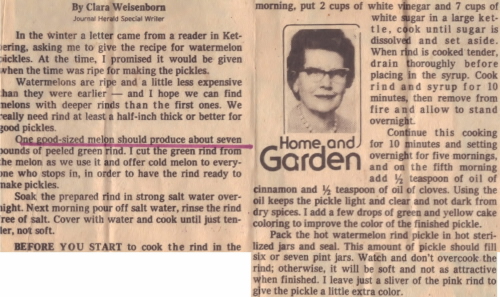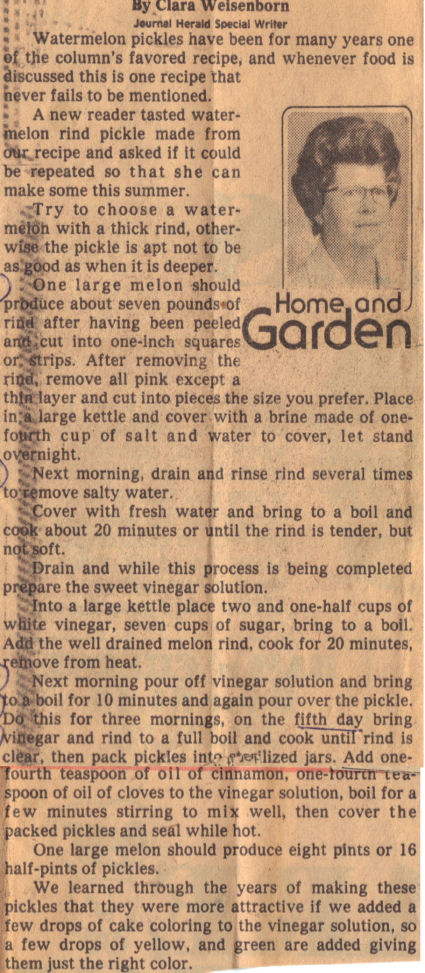Here are two different articles written by Clara Weisenborn for the “Journal Herald”, dates of clippings are unknown but the 2nd was several years after the first judging by the pictures of the author. Each article gives tips and a recipe for making the pickles, I’ve typed and scanned each below.
How To Make Watermelon Rind Pickles – Two Recipe Articles

In the winter a letter came from a reader in Kettering, asking me to give the recipe for watermelon pickles. At the time, I promised it would be given when the time was ripe for making the pickles.
Watermelons are ripe and a little less expensive than they were earlier — and I hope we can find melons with deeper rinds than the first ones. We really need rind at least a half-inch thick or better for good pickles.
One good-sized melon should produce about seven pounds of peeled green rind. I cut the green rind from the melon as we use it and offer cold melon to everyone who stops in, in order to have the rind ready to make pickles.
Soak the prepared rind in strong salt water overnight. Next morning pour off salt water, rinse the rind free of salt. Cover with water and cook until just tender, not soft.
BEFORE YOU START to cook the rind in the morning, put 2 cups of white vinegar and 7 cups of white sugar in a large kettle, cook until sugar is dissolved and set aside.
When rind is cooked tender, drain thoroughly before placing in the syrup. Cook rind and syrup for 10 minutes, then remove from fire and allow to stand overnight.
Continue this cooking for 10 minutes and setting overnight for five mornings, and on the fifth morning add 1/2 teaspoon of oil of cinnamon and 1/2 teaspoon of oil of cloves. Using the oil keeps the pickle light and clear and not dark from dry spices. I add a few drops of green and yellow cake coloring to improve the color of the finished pickle.
Pack the hot watermelon rind pickle in hot sterilized jars and seal. This amount of pickle should fill six or seven pint jars. Watch and don’t overcook the rind; otherwise, it will be soft and not as attractive when finished. I leave just a sliver of the pink rind to give the pickle a little extra color.
Second Article: (scanned copy at bottom)
Watermelon pickles have been for many years one of the column’s favored recipe, and whenever food is discussed this is one recipe that never fails to be mentioned.
A new reader tasted watermelon rind pickle made from our recipe and asked if it could be repeated so that she can make some this summer.
Try to choose a watermelon with a thick rind, otherwise the pickle is apt not to be as good as when it is deeper.
One large melon should produce about seven pounds of rind after having been peeled and cut into one-inch squares or strips. After removing the rind, remove all pink except a thin layer and cut into pieces the size you prefer. Place in a large kettle and cover with a brine made of one-fourth cup of salt and water to cover, let stand overnight.
Next morning, drain and rinse rind several times to remove salty water.
Cover with fresh water and bring to a boil and cook about 20 minutes or until the rind is tender, but not soft.
Drain and while this process is being completed prepare the sweet vinegar solution.
Into a large kettle place two and one-half cups of white vinegar, seven cups of sugar, bring to a boil. Add the well drained melon rind, cook for 20 minutes, remove from heat.
Next morning pour off vinegar solution and bring to a boil for 10 minutes and again pour over the pickle. Do this for three mornings, on the fifth day bring vinegar and rind to a full boil and cook until rind is clear, then pack pickles into sterilized jars. Add one-fourth teaspoon of oil of cinnamon, one-fourth teaspoon of oil of cloves to the vinegar solution, boil for a few minutes stirring to mix well, then cover the packed pickles and seal while hot.
One large melon should produce eight pints or 16 half-pints of pickles.
We learned through the years of making these pickles that they were more attractive if we added a few drops of cake coloring to the vinegar solution, so a few drops of yellow, and green are added giving them just the right color.

Before using this recipe, it’s important to read this page, the “Safe Canning & Food Preservation” section.
 More Recipes For You To Enjoy:
More Recipes For You To Enjoy:
4 Responses to How To Make Watermelon Rind Pickles – 2 Vintage Clippings
Does anyone have a delicious bundt cake recipe made with this rind…I had it at one time and lost track of it…!
yes i made it.
Love this article!! Been making watermelon rind for years & now have it tweaked to a faster recipe that doesn’t take all the heating & cooling & soaking. My biggest problem is finding thick melon rind…. hybrids melons are soooo thin. Guess people want more pink than white these days. Some batches I use ground spices to color the rind …some batches I use whole spices to keep it clear… depends on my mood! LOL!!
My mother-in-law made watermelon pickles this way back in the 70’s. She probably found Clara Weisenborn’s recipe in the newspaper before then and adopted it because the pickles were so good. We tried to make some watermelon rind pickles last summer using the recipes from this website and had a hard time locating the clove and cinnamon oils, but eventually bought them on line. The process is labor intensive and the results are exactly the same as the pickled rinds my wife’s mother made. We never expected to enjoy the wonderful old flavors from nearly 50 years ago. We cut the rind pieces leaving a little red on each piece and the finished pickles are beautiful. Canned them in 1/2 pint jars, they look beautiful and make great gifts to our senior friends with old fashioned taste buds. Thank you for posting these old recipes.



